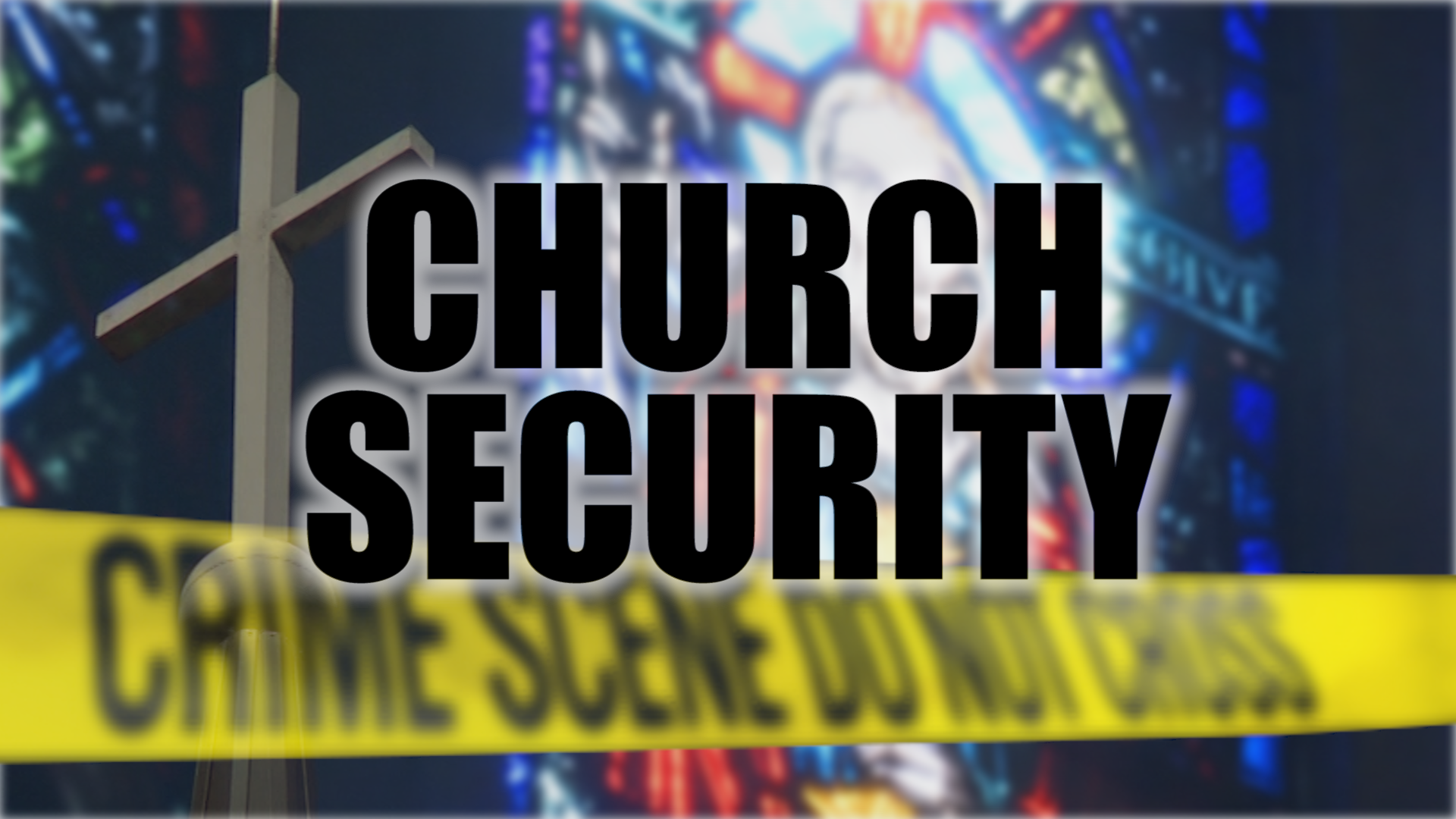Proactive Steps For A Safe Church
The purpose of a Church security and safety program (ministry) is to make safety and security part of the Church culture (philosophy) through Prevention, Protection, Detection, and Response. Church safety is everyone’s responsibility, it says so in the Bible; “Where no counsel is, the people fall: but in the multitude of counsellors there is safety”. (Proverbs 11:14)
What is Security? The simplest definition – is “creating inconvenience” to the “potential” aggressor or criminal.
How do we do that? How do we PREVENT a crime?

Our role is to REMOVE one of these elements……..usually OPPORTUNITY
A safe and secure church means that all of the People, Places, Property, Programs and Processes of the Church are functioning in a way that is as free from the potential for harm as possible, twenty-four hours a day, every day, in every service and activity. At the same time, leaders, volunteers and church members are ready to respond to a threat or emergency of any kind, to get assistance and to help themselves and others.
The first line of defense is EVERYONE. Ezekiel 33:
4 Then whosoever heareth the sound of the trumpet, and taketh not warning; if the sword come, and take him away, his blood shall be upon his own head.
5 He heard the sound of the trumpet, and took not warning; his blood shall be upon him. But he that taketh warning shall deliver his soul.
6 But if the watchman see the sword come, and blow not the trumpet, and the people be not warned; if the sword come, and take any person from among them, he is taken away in his iniquity; but his blood will I require at the watchman's hand.
It is prudent and responsible to continuously observe people and the environment for recognition of potential danger and respond appropriately. We must balance the need to provide a feeling of welcome and openness with being watchful and appropriately wary.
Church members of all ages can help protect themselves and others if they are given tips about how to report their concerns immediately, and how to respond to situations that might occur.
Children: Even very small children can be taught to tell adults immediately about persons or situations that are strange or scary.
Adults and young adults: Adult and teenage church members should be briefed on the overall security plan of the church and the role of greeters, ushers and others. They should also be given guidelines about common safety and security concerns and how to respond effectively.
All members: Everyone should be encouraged to be observant about persons and situations in the parking lot, in areas adjacent to the Church, in rooms and hallways inside the Church; and before, during and after services and activities. Teach them to write down license plate numbers or physical descriptions.
Inform the Pastor about potential problems: Members should inform the Pastor or Church staff immediately if there is a risk issue.
An ALERT word, phrase or signal: Consider establishing an alert code word, phrase or signal.
There are many opinions and theories for how best to respond to a violent encounter.
A. Determine where the threat is, if you are not in the immediate vicinity of the aggressor.
B. If in the immediate vicinity, GET DOWN and GET COVER (note: Cover means getting behind or under something that will shield and protect you. Don’t confuse concealment (hiding) – getting under a desk or table – as protection/cover).
C. If not in the immediate vicinity of the aggressor, then two options exist; one- GET OUT of the building and STAY OUT. (note: A good way to summons help is to pull the Fire Alarm). A second option, if you can’t get out is to LOCK DOWN – IN PLACE, by staying in the room you’re in or finding a room that can be secured by a locked door the aggressor can’t get in and STAY PUT until help arrives.
You may also be directing others to take these same actions the same time you are or gathering them (children) into a safe room (shelter).
“And thou shalt be secure, because there is hope; yea, thou shalt dig about thee, and thou shalt take thy rest in safety”. (Job 11:18)
New Paragraph

Also published in the Sword of the Lord I. Introduction When the Apostle Paul penned the inspired words to his understudy Timothy, stating “This know also, that in the last days perilous times shall come” (2 Tim 3:1), I doubt he could visualize or imagine the shooting of multiple persons inside of Churches. II. A Sample of the Recent History of Violence Against the Church June 22, 1980; First Baptist Church - Daingerfield, Texas A gunman attacked the Sunday morning service, coming through the sanctuary doors, yelling “this is war,” and firing into the congregation. He killed a seven-year-old girl, an adult woman, and three adult men in the shooting, which lasted barely one minute. March 12, 2005; Living Church of God - Brookfield, Wisconsin Angry at his pastor’s sermon, a man left the Sunday morning service and came back in shooting. He killed the pastor and six others before killing himself. June 17, 2015; Emanuel A.M.E. Church – Charleston, South Carolina For nearly an hour prior to the attack, the shooter had been present and participating in the Bible study. He started to disagree when they began discussing Scripture. Nine people were shot and killed, including the senior pastor, state senator Clementa C. Pinckney; a tenth person was shot and survived. III. What Do We Do Now? Church is our refuge. Church is the one place where we can go to get away from the world and find peace. Having said this, it seems security issues and safety concerns seem out of place. But a quick read in the Book of Nehemiah in Chapter 4, verse 9 and we get the verification we need. “Nevertheless we made our prayer unto God, and set a watch against them day and night, because of them”. It’s the “them” we are going to focus on. IV. What Could Possibly Happen? Listed here are a few things that could happen to any Church anywhere in the United States on any given day. They are listed for illustration purposes primarily, but are not beyond the realm of possibility for occurrence. They are not listed in any order of likelihood for happening. These are offered for reference and to provoke thought – just in case. 1. Crimes against people and property. 2. Violent actions (assault with a weapon; knife, gun, club; fights, etc.) by or involving individuals or groups; targeting one person, a group or the congregation. 3. Natural disasters and weather emergencies. 4. Accidents and injuries from minor to fatal. (bus ministry) V. Practical Steps for Church Safety and Security The purpose of a Church security and safety program (ministry) is to make safety and security part of the Church culture (philosophy) through Prevention, Protection, Detection, and Response. Church safety is everyone’s responsibility, it says so in the Bible; “Where no counsel is, the people fall: but in the multitude of counsellors there is safety”. (Proverbs 11:14) 1. All Church approach (PREVENTION) A safe and secure church means that all of the People, Places, Property, Programs and Processes of the Church are functioning in a way that is as free from the potential for harm as possible, twenty-four hours a day, every day, in every service and activity. At the same time, leaders, volunteers and church members are ready to respond to a threat or emergency of any kind, to get assistance and to help themselves and others. a. People: b. Places: c. Property: d. Programs: e. Processes: 2. The First Line of Defense (PREVENTION / PROTECTION) The first line of defense is EVERYONE. But realistically, the Greeters and Ushers are the persons who are likely to see nearly every person entering the Church during service times. Greeters, ushers, deacons, assistant pastors, teachers and the Pastor, all share responsibility for the safety and security of the congregation. It is prudent and responsible to continuously observe people and the environment for recognition of potential danger and respond appropriately. We must balance the need to provide a feeling of welcome and openness with being watchful and appropriately wary. 3. The Security Role of Ushers and Greeters (PROTECTION / DETECTION) A. You serve as a representative of the church and the pastor. As a Greeter or Usher, your assignment may be in the auditorium or sanctuary and focused on seating people, or you may be at the front door or in the lobby, busy with greeting and handing out materials. B. Your primary security tasks are to observe and assess, then get assistance or take appropriate emergency action. We need to know what to look for and what to do if we see something of concern. Observe with purpose. Hands and body first. Before you make eye contact, look at the hands, general appearance, items being carried or worn, and the overall actions and demeanor of the person you’re greeting. Body language and verbal language do not always coincide. If in doubt, always pay attention to BODY LANGUAGE. Ideally, each Greeter and Usher should have an assigned location and stay in that general area throughout the greeting time. Limited entry areas after services start; Consider reducing the number of doors that are open and post a sign about which door should be used after that time. 4. Including Church Members in the Security Program (DETECTION) Church members of all ages can help protect themselves and others if they are given tips about how to report their concerns immediately, and how to respond to situations that might occur. Children: Even very small children can be taught to tell adults immediately about persons or situations that are strange or scary. Adults and young adults: Adult and teenage church members should be briefed on the overall security plan of the church and the role of greeters, ushers and others. They should also be given guidelines about common safety and security concerns and how to respond effectively. All members: Everyone should be encouraged to be observant about persons and situations in the parking lot, in areas adjacent to the Church, in rooms and hallways inside the Church; and before, during and after services and activities. Teach them to write down license plate numbers or physical descriptions. Inform the Pastor about potential problems: Members should inform the Pastor or Church staff immediately if there is a risk issue. An ALERT word, phrase or signal: Consider establishing an alert code word, phrase or signal. 5. How Should We Respond to a Violent or Threatening Situation? (RESPONSE) There are many opinions and theories for how best to respond to a violent encounter. A. Determine where the threat is, if you are not in the immediate vicinity of the aggressor. B. If in the immediate vicinity, GET DOWN and GET COVER (note: Cover means getting behind or under something that will shield and protect you. Don’t confuse concealment (hiding) – getting under a desk or table – as protection/cover). C. If not in the immediate vicinity of the aggressor, then two options exist; one- GET OUT of the building and STAY OUT. (note: A good way to summons help is to pull the Fire Alarm). A second option, if you can’t get out is to LOCK DOWN – IN PLACE, by staying in the room you’re in or finding a room that can be secured by a locked door the aggressor can’t get in and STAY PUT until help arrives. You may also be directing others to take these same actions the same time you are or gathering them (children) into a safe room (shelter). Let us be diligent to teach our Church members, engaging them in the principles and practices of safety so that it becomes habit. The end product is a body of believers who “by their works” prevents, protects, detects, and responds to concerns and issues they perceive as unsafe or threatening to create and sustain a healthy and vibrant Church to the Glory of God the Father. “And thou shalt be secure, because there is hope; yea, thou shalt dig about thee, and thou shalt take thy rest in safety”. (Job 11:18) Bibliography Rowe, Tina Lewis; How to Assess the Safety and Security of Your Place of Worship; (www.tinalewisrowe.com); 2009 Chinn, Carl; Ministry Violence Statistics; http://www.carlchinn.com/Church_Security_Concepts.html; 2015

